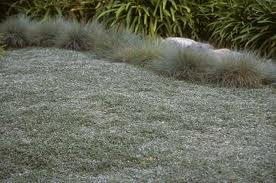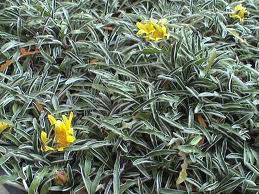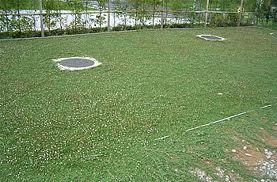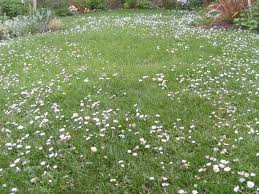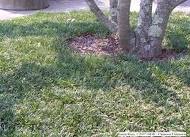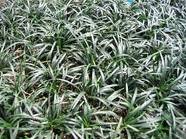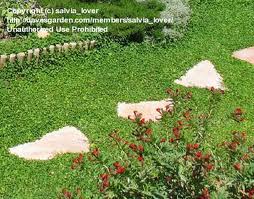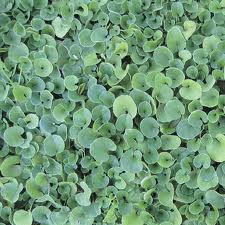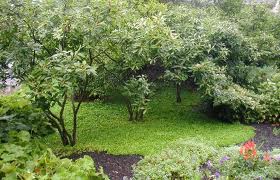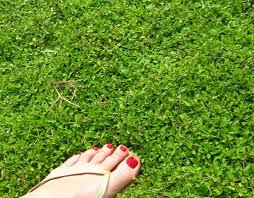So I we started the week with something lighthearted as well as thought provoking. If you missed it (https://roomtogrowgardens.wordpress.com/2011/07/04/god-and-lawn-care/)
Now don’t get us wrong, Lawn certainly has it’s place in suitable landscape settings, but we should and can offer more waterwise, lower maintenance and practical options such as:
Dymondia margaretae
This beauty is widely used in horticulture as a hardy, stout groundcover and filler between stepping stones. It is a valuable landscape plant with its attractive appearance and hardiness and can be used in rockeries and coastal gardens. It is also well known as a lawn substitute. It handles light or limited pedestrian traffic and survives with lower water consumption than grass, making it an excellent water-wise alternative.It is a valuable plant in a coastal garden, helping to limit wind erosion in bare patches and retain soil on slopes. In areas of high rainfall it should be grown on a generous slope or raised rockery to improve drainage. It will tolerate being grown in light dry shade, but dies back in large unsightly patches if overwatered. It is tolerant of light frost.
Lippia repens
Commonly known as Daisy Lawn, this ground-hugging perennial has excellent tolerance to foot-traffic, even children and dogs. Clusters of white to lavender-pink flowers appear from spring to autumn. Flowers are attractive to bees; mow periodically if this is a problem. Forms a neat, dense mat of grey-green oval leaves. An ideal turf substitute where hardy. Very drought tolerant once established. Will take semi shade to full sun conditions.
Ophiopogon japonicas
A ground cover that looks like turf grass but needs less water. Dwarf mondo grass is similar to liriope (Liriope muscari), but it has thinner leaves and a finer texture. It grows 5 to 10cm tall. When established, it is drought-tolerant, pest-resistant and only has to be mowed once a year. Dwarf mondo grass grows well in shade where turf grass is difficult to grow. It will adapt to sunny sites if it is irrigated during establishment.
Dichondra repens
Commonly known as Wonderlawn this creeping-species has single, round- to heart-shaped leaves and covers densely. It is best planted in full sun to semi-shade. Suitable for most growing regions without severe frost and is ideal for areas with high summer rainfall. Wonderlawn does require regular watering and well-draining soil, enriched with compost. A Spring-application of complete fertiliser is recommended and one must watch out for fungal diseases.
Dichondra Repens is a warm season ground cover that grows close to the ground. It has broad, almost circular leaves and when mown low establishes a thick dense carpet look. Originally a weed, it is now used in many ground cover situations where normal grasses may not do as well. It has a bright green color and a cushion feel underfoot. Beautiful in landscaping areas of no maintenance where adapted, and does not need to be mown. When used in lawn situations it can be mown for an even, smooth finish. It needs well draining soils and deep waterings, not shallow waterings.
Mazus reptans
Mazus is a low-growing ground cover which typically grows only to 5cm tall. Creeping Mazus is easily grown in average, medium to wet, well-drained soil in full sun to part shade. Prefers moist, rich soils and will tolerate foot traffic and an infrequent mowing. It features narrow, bright green leaves (to 2cm long) that form a dense, attractive carpet of foliage which remains green throughout the growing season and well into the autumn. Foliage is evergreen in South Africa. Tiny, purplish-blue, tubular, 2-lipped flowers with yellow and white markings appear in small clusters in late spring to early summer. Excellent ground cover for small areas and is also effective grown between stepping stones or in rock gardens. Slugs and snails may be a problem.
It is important to remember that like lawn and other other plant species, these substitutes have specific light, soil and water requirements and one must be sure that the right alternative is chosen in order that the plant is able to deliver on your expectation as well develop and grow healthily.
I thought I’d start the week with something lighthearted. It makes you think though.
Will look at lawn alternatives later in the week.
GOD & LAWN CARE
God said: “St Francis, you know all about gardens and nature. What in
the world is going on down there on the planet? What happened to the
dandelions, violets, milkweeds and stuff I started eons ago? I had a
perfect no-maintenance garden plan. Those plants grow in any type of
soil, withstand drought and multiply with abandon. The nectar from the
long-lasting blossoms attracts butterflies, honey bees and flocks of
songbirds. I expected to see a vast garden of colors by now. But, all
I see are these green rectangles.”
St. FRANCIS:
It’s the tribes that settled there, Lord. The Suburbanites. They
started calling your flowers ‘weeds’ and went to great lengths to kill
them and replace them with grass.
GOD:
Grass? But, it’s so boring. It’s not colorful. It doesn’t attract
butterflies, birds and bees; only grubs and sod worms. It’s sensitive
to temperatures. Do these Suburbanites really want all that grass
growing there?
ST. FRANCIS:
Apparently so, Lord. They go to great pains to grow it and keep it
green. They begin each spring by fertilizing grass and poisoning any
other plant that crops up in the lawn.
GOD:
The spring rains and warm weather probably make grass grow really
fast. That must make the Suburbanites happy.
ST. FRANCIS:
Apparently not, Lord. As soon as it grows a little, they cut
it-sometimes twice a week.
GOD:
They cut it? Do they then bale it like hay?
ST. FRANCIS:
Not exactly, Lord. Most of them rake it up and put it in bags.
GOD:
They bag it? Why? Is it a cash crop? Do they sell it?
ST. FRANCIS:
No, Sir, just the opposite. They pay to throw it away.
GOD:
Now, let me get this straight. They fertilize grass so it will grow.
And, when it does grow, they cut it off and pay to throw it away?
ST. FRANCIS:
Yes, Sir.
GOD:
These Suburbanites must be relieved in the summer when we cut back on
the rain and turn up the heat. That surely slows the growth and saves
them a lot of work.
ST. FRANCIS:
You aren’t going to believe this, Lord. When the grass stops growing
so fast, they drag out hoses and pay more money to water it, so they
can continue to mow it and pay to get rid of it.
GOD:
What nonsense. At least they kept some of the trees. That was a sheer
stroke of genius, if I do say so myself. The trees grow leaves in the
spring to provide beauty and shade in the summer. In the autumn, they
fall to the ground and form a natural blanket to keep moisture in the
soil and protect the trees and bushes. It’s a natural cycle of life.
ST. FRANCIS:
You better sit down, Lord. The Suburbanites have drawn a new circle.
As soon as the leaves fall, they rake them into great piles and pay to
have them hauled away.
GOD:
No!? What do they do to protect the shrub and tree roots in the winter
to keep the soil moist and loose?
ST. FRANCIS:
After throwing away the leaves, they go out and buy something which
they call mulch.. They haul it home and spread it around in place of
the leaves.
GOD:
And where do they get this mulch?
ST. FRANCIS:
They cut down trees and grind them up to make the mulch.
GOD:
Enough! I don’t want to think about this anymore. St. Catherine,
you’re in charge of the arts. What movie have you scheduled for us
tonight?
ST. CATHERINE:
‘Dumb and Dumber’, Lord. It’s a story about….
GOD:
Never mind, I think I just heard the whole story from St. Francis.
The 2011 SALI (South African Landscape Institute) Awards of Excellence were presented in June 2011 and Roomtogrow is proud to announce that we scooped 3 Golds as well as the Trophy for the Best Specialised landscape construction in the country.
The Trophy is particularily exciting as this is the second time in three years that we have been awarded this.
We first entered our work in 2008 and since then have received 8 Golds, 4 Silvers and 2 Trophies.
